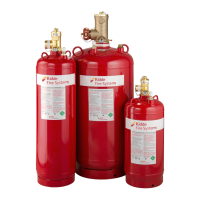Post-Discharge Maintenance
06-236115-001 6-15 October 2014
6-4 NITROGEN PILOT CYLINDER SERVICE AND MAINTENANCE
6-4.1 Nitrogen Driver Cylinder Hydrostatic Pressure Test
A hydrostatic test must be performed in accordance with the DOT Regulatory Compliance Guide,
49 CFR 180.209
. Nitrogen cylinders shall not be recharged and shipped without hydrostatic test
if more than five years has elapsed from the date of the last test.
Nitrogen cylinders continuously in service without discharging can be retained in service for a
maximum of five years from the date of the last hydrostatic test. At the end of five years the
cylinder shall be visually inspected per CGA pamphlet C-6.
Cylinders must also be hydrostatic pressure tested immediately if the cylinder shows evidence
of distortion, cracking, corrosion or mechanical or fire damage.
6-4.2 Nitrogen Cylinder Replacement
Replace the nitrogen cylinder when expended or when loss of pressure occurs, as follows:
1. Remove the control head from the nitrogen driver cylinder valve.
2. Immediately install the protection cap on the nitrogen cylinder actuation port.
3. Remove the flexible actuation hose or tubing and adapter (P/N WK-699205-010) from the
cylinder valve outlet.
4. Remove the clamps and hardware that secure the nitrogen cylinder to the mounting
bracket.
WARNING
Any area in which nitrogen is used or stored must be properly ventilated. A
person working in an area where air has become enriched with nitrogen can
become unconscious without sensing the lack of oxygen. Remove the victim to
fresh air. Administer artificial respiration if necessary and summon a physician.
Never dispose of liquefied nitrogen in an indoor work or storage area.
WARNING
When removing a pressurized cylinder due to pressure loss, the control head
must be in the SET position with the safety pull pin installed. A control head in
the released position will cause the remaining contents of cylinder to discharge
resulting in a system activation which may damage property and cause bodily
injury.

